University Biomechanics Report: Body Movements in Competitive Swimming
VerifiedAdded on 2022/09/18
|30
|7936
|23
Report
AI Summary
This systematic literature review investigates the biomechanics of body movements during competitive swimming, focusing on the interplay of kinetic, kinematic, and neuromuscular variables. The study examines how stroke length, stroke frequency, propulsive force, drag force, and joint movements influence swimmer performance. It delves into the kinetics of swimming, including propulsive and drag forces, and explores the kinematics of stroke cycles, limb movements, and the center of mass. The report also analyzes the biomechanics of joint movements, specifically the gleno-humeral and scapula-thoracic joints, providing a comprehensive understanding of the factors that contribute to efficient and effective swimming techniques. The research utilizes a range of databases to gather relevant information, including PubMed and Web of Science. Furthermore, it highlights the significance of these biomechanical factors in enhancing a swimmer's performance. The report concludes by summarizing the key findings and implications for improving swimming techniques and training methodologies.
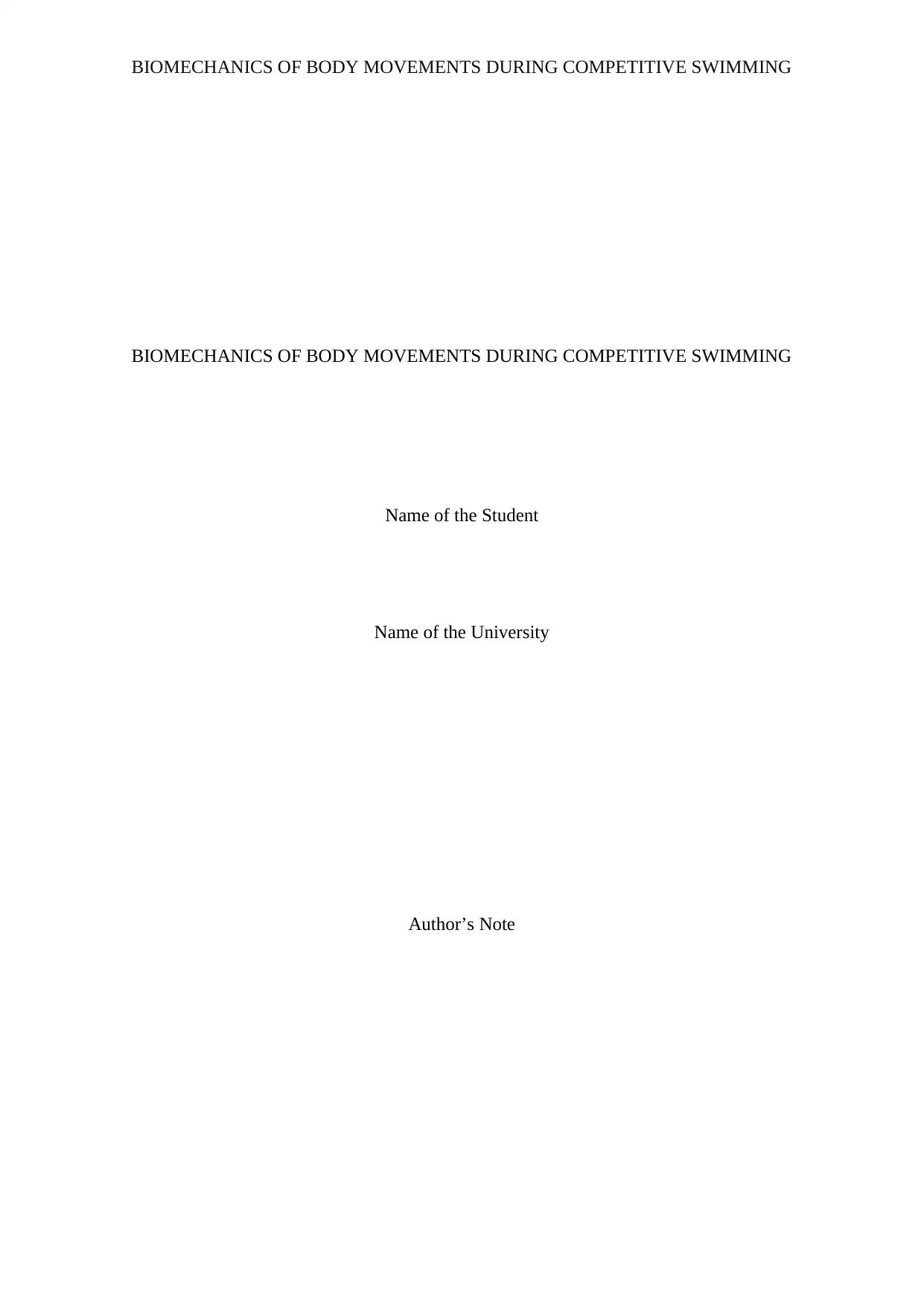
BIOMECHANICS OF BODY MOVEMENTS DURING COMPETITIVE SWIMMING
BIOMECHANICS OF BODY MOVEMENTS DURING COMPETITIVE SWIMMING
Name of the Student
Name of the University
Author’s Note
BIOMECHANICS OF BODY MOVEMENTS DURING COMPETITIVE SWIMMING
Name of the Student
Name of the University
Author’s Note
Paraphrase This Document
Need a fresh take? Get an instant paraphrase of this document with our AI Paraphraser
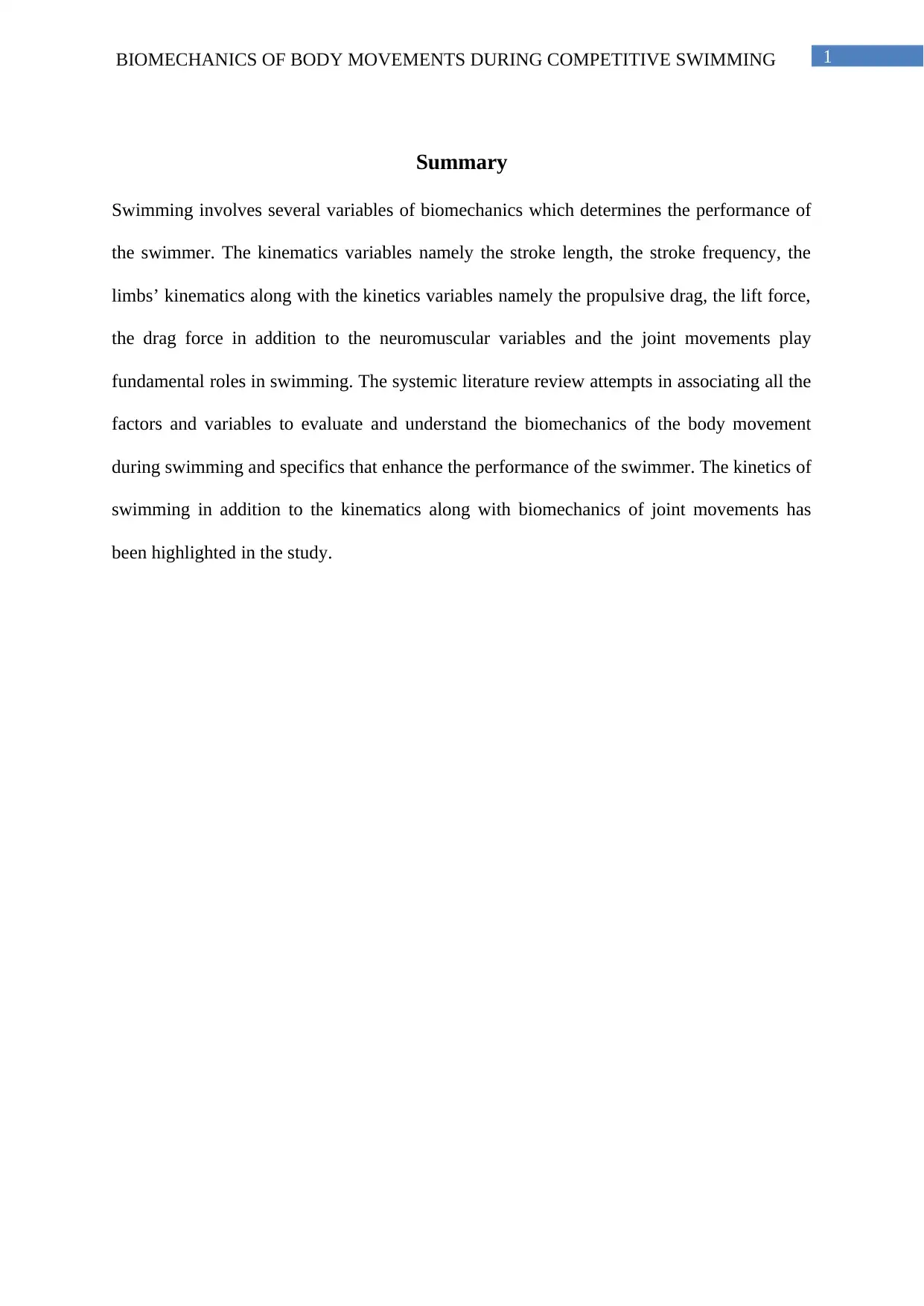
1BIOMECHANICS OF BODY MOVEMENTS DURING COMPETITIVE SWIMMING
Summary
Swimming involves several variables of biomechanics which determines the performance of
the swimmer. The kinematics variables namely the stroke length, the stroke frequency, the
limbs’ kinematics along with the kinetics variables namely the propulsive drag, the lift force,
the drag force in addition to the neuromuscular variables and the joint movements play
fundamental roles in swimming. The systemic literature review attempts in associating all the
factors and variables to evaluate and understand the biomechanics of the body movement
during swimming and specifics that enhance the performance of the swimmer. The kinetics of
swimming in addition to the kinematics along with biomechanics of joint movements has
been highlighted in the study.
Summary
Swimming involves several variables of biomechanics which determines the performance of
the swimmer. The kinematics variables namely the stroke length, the stroke frequency, the
limbs’ kinematics along with the kinetics variables namely the propulsive drag, the lift force,
the drag force in addition to the neuromuscular variables and the joint movements play
fundamental roles in swimming. The systemic literature review attempts in associating all the
factors and variables to evaluate and understand the biomechanics of the body movement
during swimming and specifics that enhance the performance of the swimmer. The kinetics of
swimming in addition to the kinematics along with biomechanics of joint movements has
been highlighted in the study.
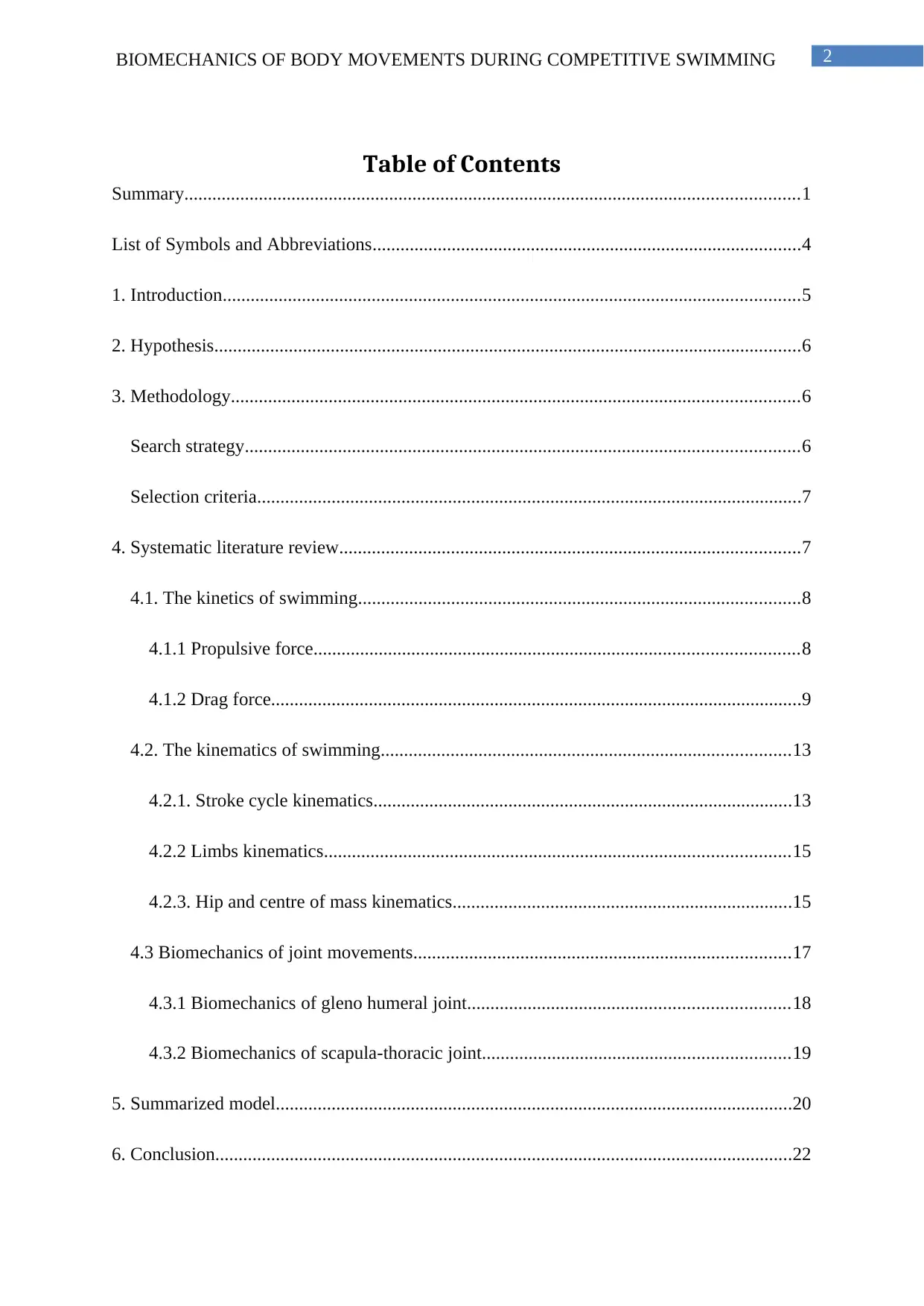
2BIOMECHANICS OF BODY MOVEMENTS DURING COMPETITIVE SWIMMING
Table of Contents
Summary....................................................................................................................................1
List of Symbols and Abbreviations............................................................................................4
1. Introduction............................................................................................................................5
2. Hypothesis..............................................................................................................................6
3. Methodology..........................................................................................................................6
Search strategy.......................................................................................................................6
Selection criteria.....................................................................................................................7
4. Systematic literature review...................................................................................................7
4.1. The kinetics of swimming...............................................................................................8
4.1.1 Propulsive force........................................................................................................8
4.1.2 Drag force..................................................................................................................9
4.2. The kinematics of swimming........................................................................................13
4.2.1. Stroke cycle kinematics..........................................................................................13
4.2.2 Limbs kinematics....................................................................................................15
4.2.3. Hip and centre of mass kinematics.........................................................................15
4.3 Biomechanics of joint movements.................................................................................17
4.3.1 Biomechanics of gleno humeral joint.....................................................................18
4.3.2 Biomechanics of scapula-thoracic joint..................................................................19
5. Summarized model...............................................................................................................20
6. Conclusion............................................................................................................................22
Table of Contents
Summary....................................................................................................................................1
List of Symbols and Abbreviations............................................................................................4
1. Introduction............................................................................................................................5
2. Hypothesis..............................................................................................................................6
3. Methodology..........................................................................................................................6
Search strategy.......................................................................................................................6
Selection criteria.....................................................................................................................7
4. Systematic literature review...................................................................................................7
4.1. The kinetics of swimming...............................................................................................8
4.1.1 Propulsive force........................................................................................................8
4.1.2 Drag force..................................................................................................................9
4.2. The kinematics of swimming........................................................................................13
4.2.1. Stroke cycle kinematics..........................................................................................13
4.2.2 Limbs kinematics....................................................................................................15
4.2.3. Hip and centre of mass kinematics.........................................................................15
4.3 Biomechanics of joint movements.................................................................................17
4.3.1 Biomechanics of gleno humeral joint.....................................................................18
4.3.2 Biomechanics of scapula-thoracic joint..................................................................19
5. Summarized model...............................................................................................................20
6. Conclusion............................................................................................................................22
⊘ This is a preview!⊘
Do you want full access?
Subscribe today to unlock all pages.

Trusted by 1+ million students worldwide

3BIOMECHANICS OF BODY MOVEMENTS DURING COMPETITIVE SWIMMING
References................................................................................................................................23
Appendices...............................................................................................................................28
Appendix 1: Hand movement during the strokes.................................................................28
Appendix 2: Forces that act on the body during swimming................................................29
References................................................................................................................................23
Appendices...............................................................................................................................28
Appendix 1: Hand movement during the strokes.................................................................28
Appendix 2: Forces that act on the body during swimming................................................29
Paraphrase This Document
Need a fresh take? Get an instant paraphrase of this document with our AI Paraphraser

4BIOMECHANICS OF BODY MOVEMENTS DURING COMPETITIVE SWIMMING
List of Symbols and Abbreviations
V= Swimming velocity
SL= Stroke length
SF= Stroke frequency
Hz= Hertz
SI= Stroke index
ηp= Propulsive efficiency
CV= critical velocity
List of Symbols and Abbreviations
V= Swimming velocity
SL= Stroke length
SF= Stroke frequency
Hz= Hertz
SI= Stroke index
ηp= Propulsive efficiency
CV= critical velocity
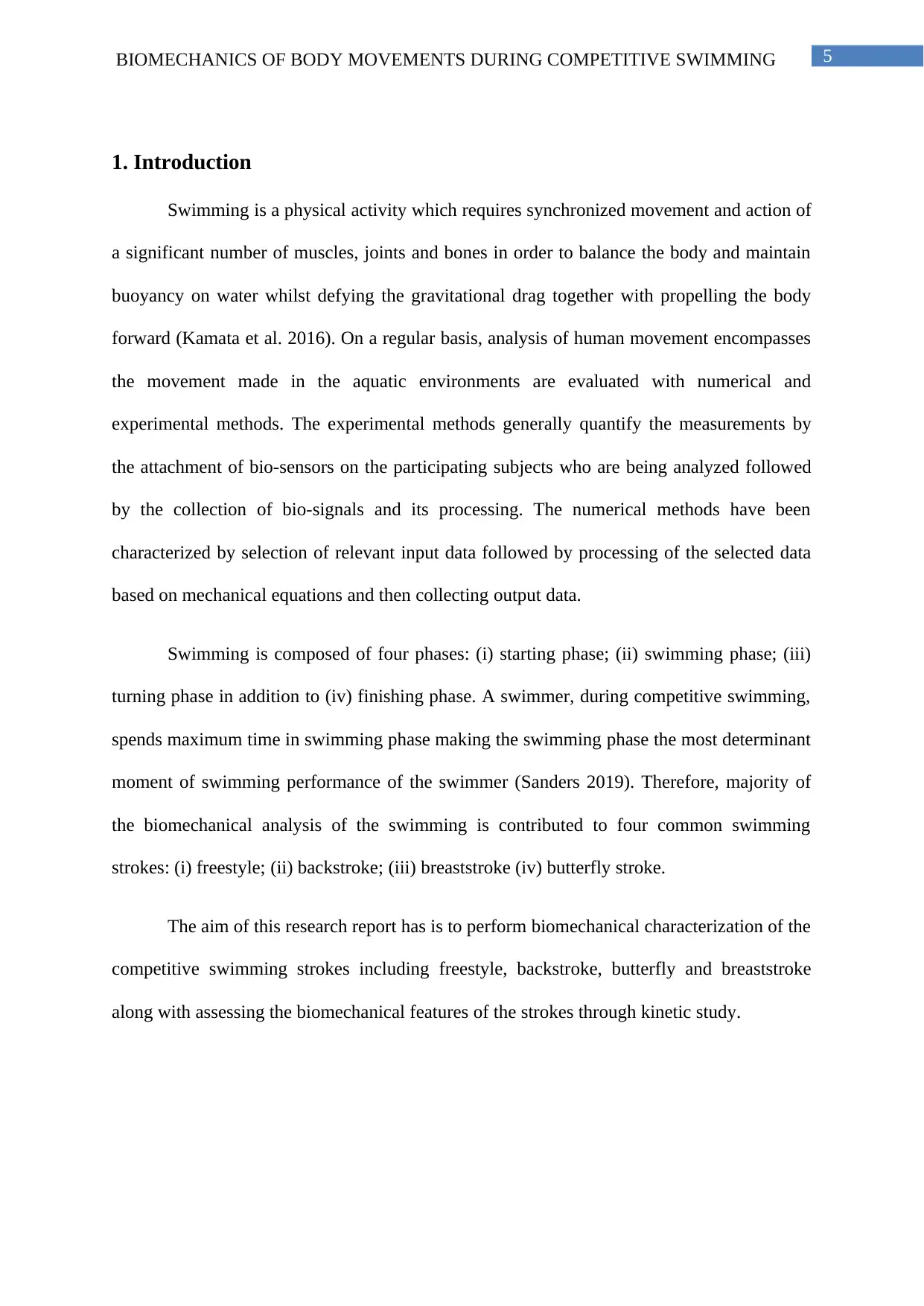
5BIOMECHANICS OF BODY MOVEMENTS DURING COMPETITIVE SWIMMING
1. Introduction
Swimming is a physical activity which requires synchronized movement and action of
a significant number of muscles, joints and bones in order to balance the body and maintain
buoyancy on water whilst defying the gravitational drag together with propelling the body
forward (Kamata et al. 2016). On a regular basis, analysis of human movement encompasses
the movement made in the aquatic environments are evaluated with numerical and
experimental methods. The experimental methods generally quantify the measurements by
the attachment of bio-sensors on the participating subjects who are being analyzed followed
by the collection of bio-signals and its processing. The numerical methods have been
characterized by selection of relevant input data followed by processing of the selected data
based on mechanical equations and then collecting output data.
Swimming is composed of four phases: (i) starting phase; (ii) swimming phase; (iii)
turning phase in addition to (iv) finishing phase. A swimmer, during competitive swimming,
spends maximum time in swimming phase making the swimming phase the most determinant
moment of swimming performance of the swimmer (Sanders 2019). Therefore, majority of
the biomechanical analysis of the swimming is contributed to four common swimming
strokes: (i) freestyle; (ii) backstroke; (iii) breaststroke (iv) butterfly stroke.
The aim of this research report has is to perform biomechanical characterization of the
competitive swimming strokes including freestyle, backstroke, butterfly and breaststroke
along with assessing the biomechanical features of the strokes through kinetic study.
1. Introduction
Swimming is a physical activity which requires synchronized movement and action of
a significant number of muscles, joints and bones in order to balance the body and maintain
buoyancy on water whilst defying the gravitational drag together with propelling the body
forward (Kamata et al. 2016). On a regular basis, analysis of human movement encompasses
the movement made in the aquatic environments are evaluated with numerical and
experimental methods. The experimental methods generally quantify the measurements by
the attachment of bio-sensors on the participating subjects who are being analyzed followed
by the collection of bio-signals and its processing. The numerical methods have been
characterized by selection of relevant input data followed by processing of the selected data
based on mechanical equations and then collecting output data.
Swimming is composed of four phases: (i) starting phase; (ii) swimming phase; (iii)
turning phase in addition to (iv) finishing phase. A swimmer, during competitive swimming,
spends maximum time in swimming phase making the swimming phase the most determinant
moment of swimming performance of the swimmer (Sanders 2019). Therefore, majority of
the biomechanical analysis of the swimming is contributed to four common swimming
strokes: (i) freestyle; (ii) backstroke; (iii) breaststroke (iv) butterfly stroke.
The aim of this research report has is to perform biomechanical characterization of the
competitive swimming strokes including freestyle, backstroke, butterfly and breaststroke
along with assessing the biomechanical features of the strokes through kinetic study.
⊘ This is a preview!⊘
Do you want full access?
Subscribe today to unlock all pages.

Trusted by 1+ million students worldwide
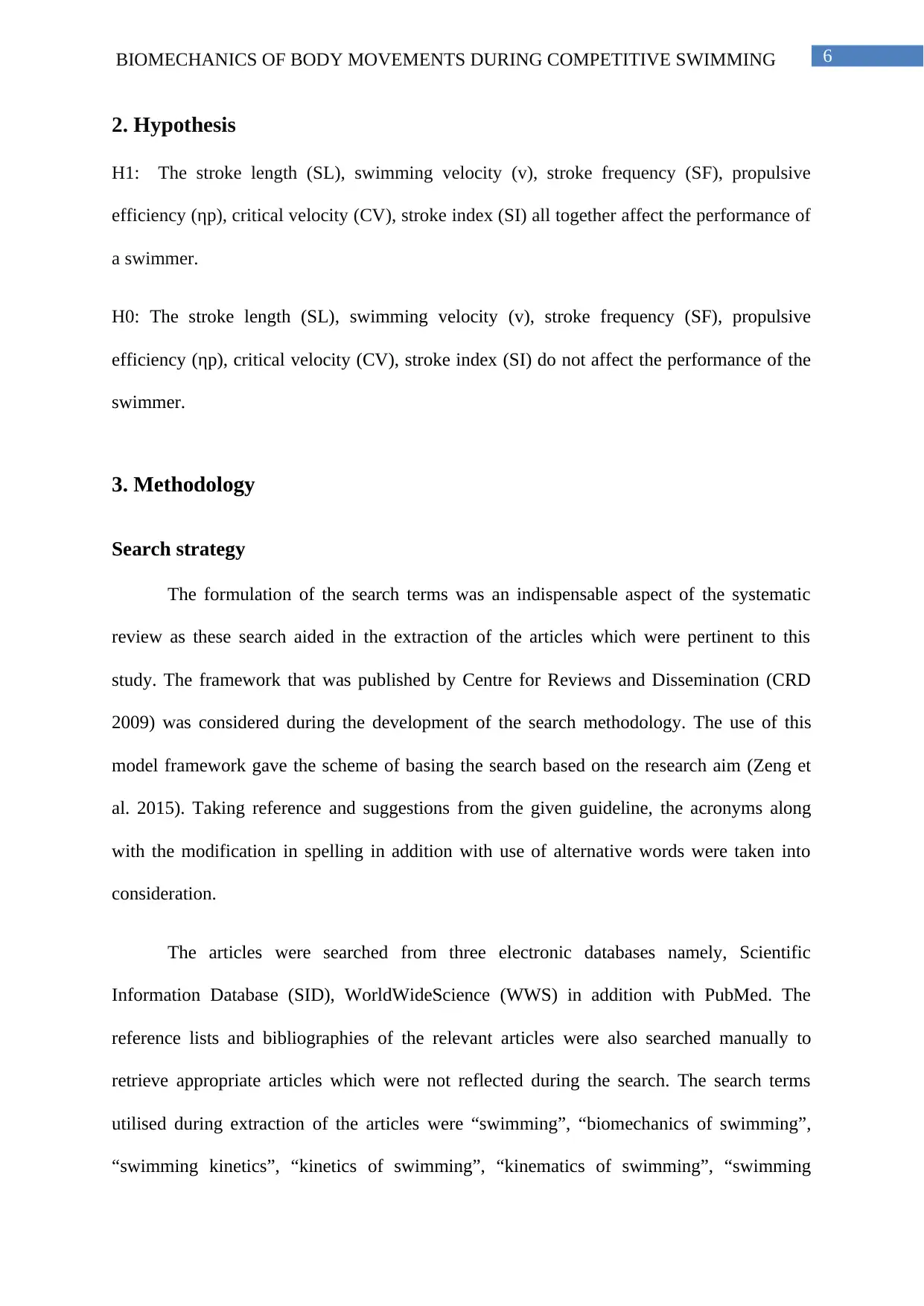
6BIOMECHANICS OF BODY MOVEMENTS DURING COMPETITIVE SWIMMING
2. Hypothesis
H1: The stroke length (SL), swimming velocity (v), stroke frequency (SF), propulsive
efficiency (ηp), critical velocity (CV), stroke index (SI) all together affect the performance of
a swimmer.
H0: The stroke length (SL), swimming velocity (v), stroke frequency (SF), propulsive
efficiency (ηp), critical velocity (CV), stroke index (SI) do not affect the performance of the
swimmer.
3. Methodology
Search strategy
The formulation of the search terms was an indispensable aspect of the systematic
review as these search aided in the extraction of the articles which were pertinent to this
study. The framework that was published by Centre for Reviews and Dissemination (CRD
2009) was considered during the development of the search methodology. The use of this
model framework gave the scheme of basing the search based on the research aim (Zeng et
al. 2015). Taking reference and suggestions from the given guideline, the acronyms along
with the modification in spelling in addition with use of alternative words were taken into
consideration.
The articles were searched from three electronic databases namely, Scientific
Information Database (SID), WorldWideScience (WWS) in addition with PubMed. The
reference lists and bibliographies of the relevant articles were also searched manually to
retrieve appropriate articles which were not reflected during the search. The search terms
utilised during extraction of the articles were “swimming”, “biomechanics of swimming”,
“swimming kinetics”, “kinetics of swimming”, “kinematics of swimming”, “swimming
2. Hypothesis
H1: The stroke length (SL), swimming velocity (v), stroke frequency (SF), propulsive
efficiency (ηp), critical velocity (CV), stroke index (SI) all together affect the performance of
a swimmer.
H0: The stroke length (SL), swimming velocity (v), stroke frequency (SF), propulsive
efficiency (ηp), critical velocity (CV), stroke index (SI) do not affect the performance of the
swimmer.
3. Methodology
Search strategy
The formulation of the search terms was an indispensable aspect of the systematic
review as these search aided in the extraction of the articles which were pertinent to this
study. The framework that was published by Centre for Reviews and Dissemination (CRD
2009) was considered during the development of the search methodology. The use of this
model framework gave the scheme of basing the search based on the research aim (Zeng et
al. 2015). Taking reference and suggestions from the given guideline, the acronyms along
with the modification in spelling in addition with use of alternative words were taken into
consideration.
The articles were searched from three electronic databases namely, Scientific
Information Database (SID), WorldWideScience (WWS) in addition with PubMed. The
reference lists and bibliographies of the relevant articles were also searched manually to
retrieve appropriate articles which were not reflected during the search. The search terms
utilised during extraction of the articles were “swimming”, “biomechanics of swimming”,
“swimming kinetics”, “kinetics of swimming”, “kinematics of swimming”, “swimming
Paraphrase This Document
Need a fresh take? Get an instant paraphrase of this document with our AI Paraphraser

7BIOMECHANICS OF BODY MOVEMENTS DURING COMPETITIVE SWIMMING
kinematics”, “biomechanics of joints”, “swimming joints”, “joints in swimming”, “swimming
biomechanics”, “swimming physics”, “swimming strokes”, “swimming strokes physics”, and
“physics of swimming”. The search terms were also combined with the aid of the boolean
operators namely ‘AND’ and ‘OR’ which helped the narrowing along with broadening of the
search results as per requirement (McGowan et al. 2016).
Selection criteria
The exclusion and inclusion criteria were also formulated to establish the attention
and priority for the articles reviewed in this systematic research based study. To maximise the
emphasis of the topic chosen for the systemic literature review, certain exclusion and
inclusion criteria were developed based on the guidelines set by Stern, Jordan and McArthur
(2014).
Table 1- Inclusion and exclusion criteria for the proposed literature review
Inclusion criteria Exclusion criteria
Articles selected were only in English Foreign language articles were excluded
Articles that highlighted swimming and the
biomechanics involved
Articles that focussed on biomechanics of
other sports were excluded
Peer reviewed articles were only selected Case studies were excluded
Only research articles were selected Manuscripts and blog contents were rejected
4. Systematic literature review
Kinetic assessment is usually done by the adoption of research designs from various
experiment based protocols. Since early 20th century, researches have been conducted for the
estimation of drag force and propelling force required for successful swimming. The pioneers
of such research are Houssay along with Cureton, Karpovich and Pestrecov from 1939
(Lewillie 2013). Techniques based on computer simulation (Bixler and Riewald 2012; Bixler
kinematics”, “biomechanics of joints”, “swimming joints”, “joints in swimming”, “swimming
biomechanics”, “swimming physics”, “swimming strokes”, “swimming strokes physics”, and
“physics of swimming”. The search terms were also combined with the aid of the boolean
operators namely ‘AND’ and ‘OR’ which helped the narrowing along with broadening of the
search results as per requirement (McGowan et al. 2016).
Selection criteria
The exclusion and inclusion criteria were also formulated to establish the attention
and priority for the articles reviewed in this systematic research based study. To maximise the
emphasis of the topic chosen for the systemic literature review, certain exclusion and
inclusion criteria were developed based on the guidelines set by Stern, Jordan and McArthur
(2014).
Table 1- Inclusion and exclusion criteria for the proposed literature review
Inclusion criteria Exclusion criteria
Articles selected were only in English Foreign language articles were excluded
Articles that highlighted swimming and the
biomechanics involved
Articles that focussed on biomechanics of
other sports were excluded
Peer reviewed articles were only selected Case studies were excluded
Only research articles were selected Manuscripts and blog contents were rejected
4. Systematic literature review
Kinetic assessment is usually done by the adoption of research designs from various
experiment based protocols. Since early 20th century, researches have been conducted for the
estimation of drag force and propelling force required for successful swimming. The pioneers
of such research are Houssay along with Cureton, Karpovich and Pestrecov from 1939
(Lewillie 2013). Techniques based on computer simulation (Bixler and Riewald 2012; Bixler
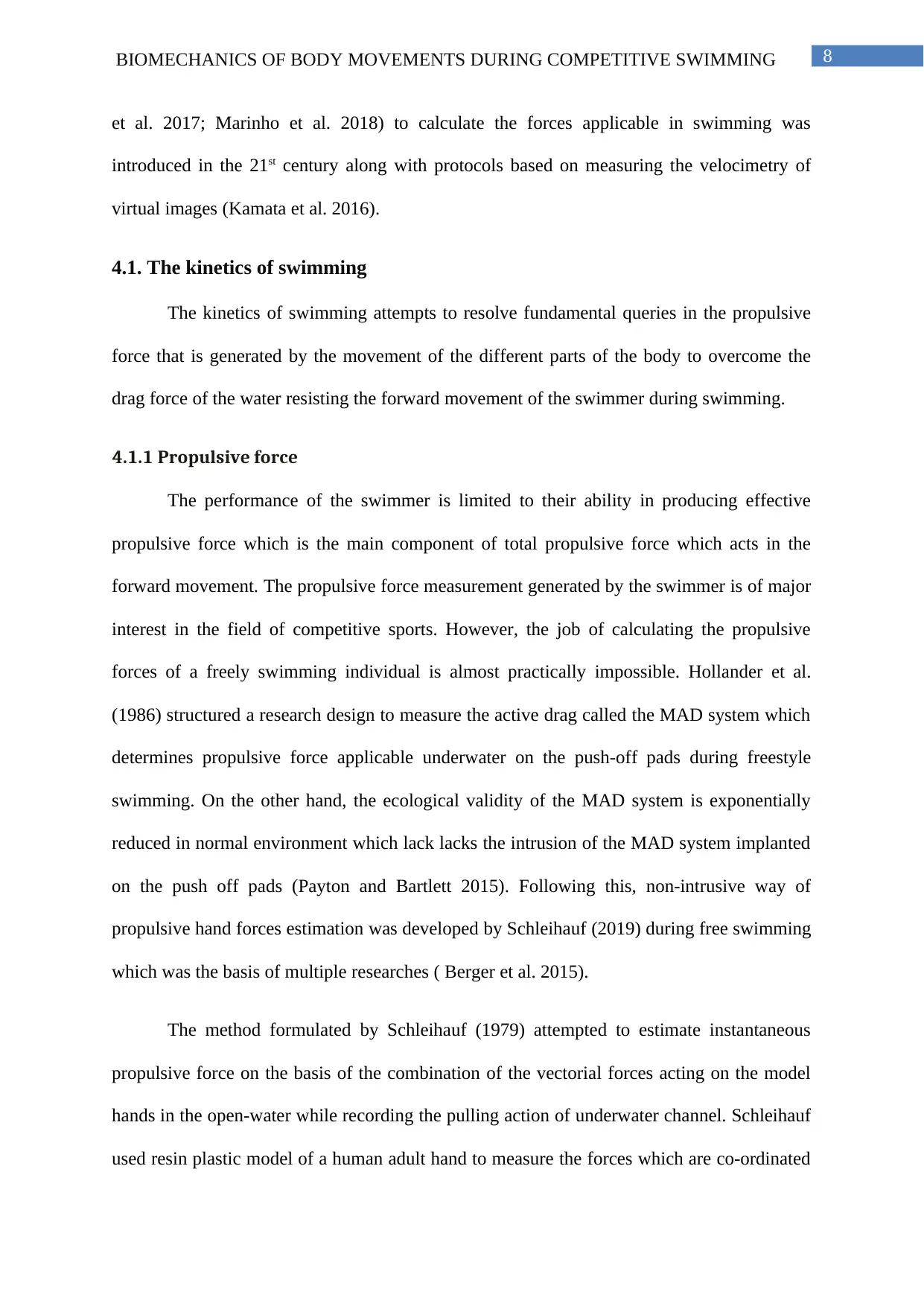
8BIOMECHANICS OF BODY MOVEMENTS DURING COMPETITIVE SWIMMING
et al. 2017; Marinho et al. 2018) to calculate the forces applicable in swimming was
introduced in the 21st century along with protocols based on measuring the velocimetry of
virtual images (Kamata et al. 2016).
4.1. The kinetics of swimming
The kinetics of swimming attempts to resolve fundamental queries in the propulsive
force that is generated by the movement of the different parts of the body to overcome the
drag force of the water resisting the forward movement of the swimmer during swimming.
4.1.1 Propulsive force
The performance of the swimmer is limited to their ability in producing effective
propulsive force which is the main component of total propulsive force which acts in the
forward movement. The propulsive force measurement generated by the swimmer is of major
interest in the field of competitive sports. However, the job of calculating the propulsive
forces of a freely swimming individual is almost practically impossible. Hollander et al.
(1986) structured a research design to measure the active drag called the MAD system which
determines propulsive force applicable underwater on the push-off pads during freestyle
swimming. On the other hand, the ecological validity of the MAD system is exponentially
reduced in normal environment which lack lacks the intrusion of the MAD system implanted
on the push off pads (Payton and Bartlett 2015). Following this, non-intrusive way of
propulsive hand forces estimation was developed by Schleihauf (2019) during free swimming
which was the basis of multiple researches ( Berger et al. 2015).
The method formulated by Schleihauf (1979) attempted to estimate instantaneous
propulsive force on the basis of the combination of the vectorial forces acting on the model
hands in the open-water while recording the pulling action of underwater channel. Schleihauf
used resin plastic model of a human adult hand to measure the forces which are co-ordinated
et al. 2017; Marinho et al. 2018) to calculate the forces applicable in swimming was
introduced in the 21st century along with protocols based on measuring the velocimetry of
virtual images (Kamata et al. 2016).
4.1. The kinetics of swimming
The kinetics of swimming attempts to resolve fundamental queries in the propulsive
force that is generated by the movement of the different parts of the body to overcome the
drag force of the water resisting the forward movement of the swimmer during swimming.
4.1.1 Propulsive force
The performance of the swimmer is limited to their ability in producing effective
propulsive force which is the main component of total propulsive force which acts in the
forward movement. The propulsive force measurement generated by the swimmer is of major
interest in the field of competitive sports. However, the job of calculating the propulsive
forces of a freely swimming individual is almost practically impossible. Hollander et al.
(1986) structured a research design to measure the active drag called the MAD system which
determines propulsive force applicable underwater on the push-off pads during freestyle
swimming. On the other hand, the ecological validity of the MAD system is exponentially
reduced in normal environment which lack lacks the intrusion of the MAD system implanted
on the push off pads (Payton and Bartlett 2015). Following this, non-intrusive way of
propulsive hand forces estimation was developed by Schleihauf (2019) during free swimming
which was the basis of multiple researches ( Berger et al. 2015).
The method formulated by Schleihauf (1979) attempted to estimate instantaneous
propulsive force on the basis of the combination of the vectorial forces acting on the model
hands in the open-water while recording the pulling action of underwater channel. Schleihauf
used resin plastic model of a human adult hand to measure the forces which are co-ordinated
⊘ This is a preview!⊘
Do you want full access?
Subscribe today to unlock all pages.

Trusted by 1+ million students worldwide
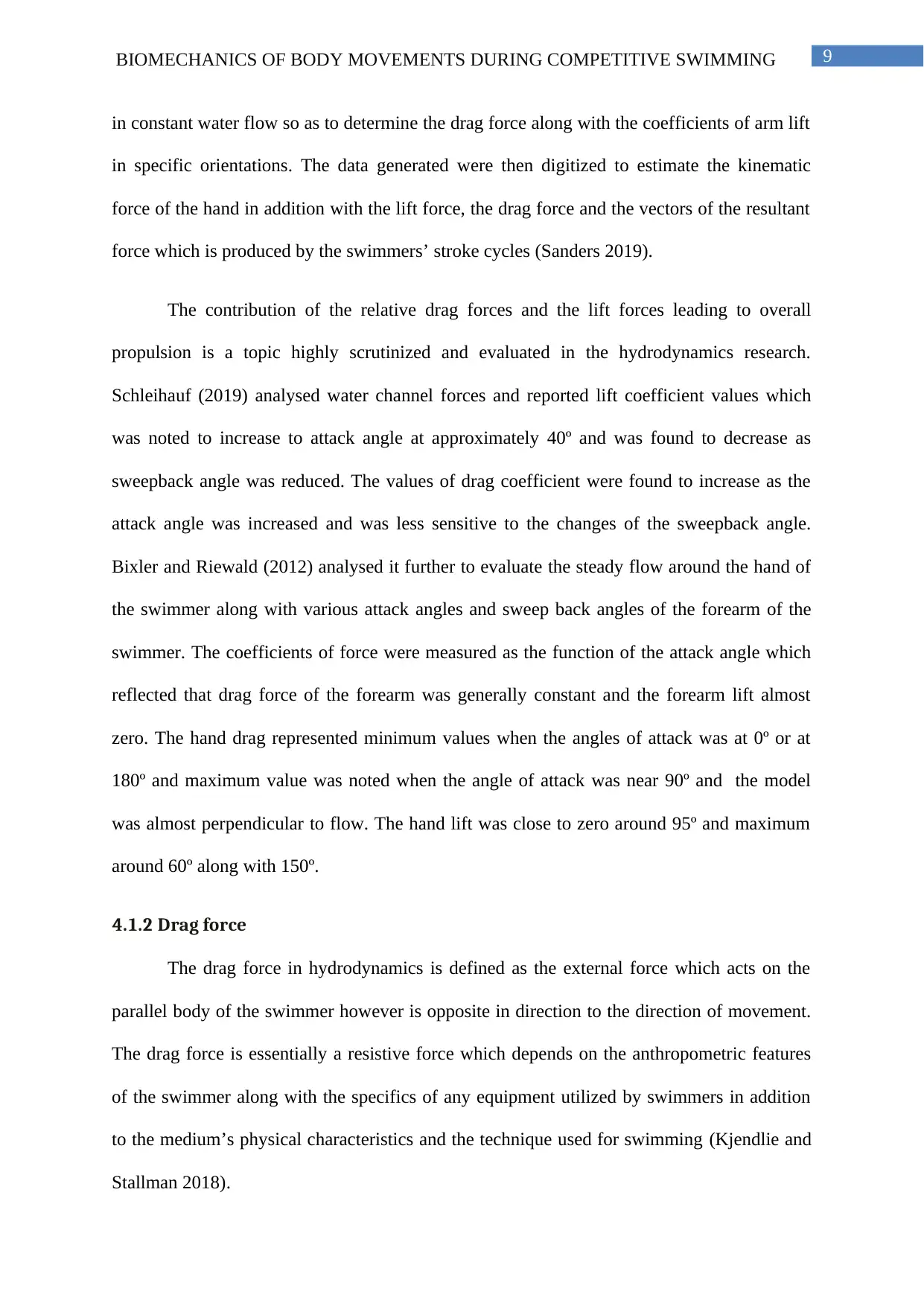
9BIOMECHANICS OF BODY MOVEMENTS DURING COMPETITIVE SWIMMING
in constant water flow so as to determine the drag force along with the coefficients of arm lift
in specific orientations. The data generated were then digitized to estimate the kinematic
force of the hand in addition with the lift force, the drag force and the vectors of the resultant
force which is produced by the swimmers’ stroke cycles (Sanders 2019).
The contribution of the relative drag forces and the lift forces leading to overall
propulsion is a topic highly scrutinized and evaluated in the hydrodynamics research.
Schleihauf (2019) analysed water channel forces and reported lift coefficient values which
was noted to increase to attack angle at approximately 40º and was found to decrease as
sweepback angle was reduced. The values of drag coefficient were found to increase as the
attack angle was increased and was less sensitive to the changes of the sweepback angle.
Bixler and Riewald (2012) analysed it further to evaluate the steady flow around the hand of
the swimmer along with various attack angles and sweep back angles of the forearm of the
swimmer. The coefficients of force were measured as the function of the attack angle which
reflected that drag force of the forearm was generally constant and the forearm lift almost
zero. The hand drag represented minimum values when the angles of attack was at 0º or at
180º and maximum value was noted when the angle of attack was near 90º and the model
was almost perpendicular to flow. The hand lift was close to zero around 95º and maximum
around 60º along with 150º.
4.1.2 Drag force
The drag force in hydrodynamics is defined as the external force which acts on the
parallel body of the swimmer however is opposite in direction to the direction of movement.
The drag force is essentially a resistive force which depends on the anthropometric features
of the swimmer along with the specifics of any equipment utilized by swimmers in addition
to the medium’s physical characteristics and the technique used for swimming (Kjendlie and
Stallman 2018).
in constant water flow so as to determine the drag force along with the coefficients of arm lift
in specific orientations. The data generated were then digitized to estimate the kinematic
force of the hand in addition with the lift force, the drag force and the vectors of the resultant
force which is produced by the swimmers’ stroke cycles (Sanders 2019).
The contribution of the relative drag forces and the lift forces leading to overall
propulsion is a topic highly scrutinized and evaluated in the hydrodynamics research.
Schleihauf (2019) analysed water channel forces and reported lift coefficient values which
was noted to increase to attack angle at approximately 40º and was found to decrease as
sweepback angle was reduced. The values of drag coefficient were found to increase as the
attack angle was increased and was less sensitive to the changes of the sweepback angle.
Bixler and Riewald (2012) analysed it further to evaluate the steady flow around the hand of
the swimmer along with various attack angles and sweep back angles of the forearm of the
swimmer. The coefficients of force were measured as the function of the attack angle which
reflected that drag force of the forearm was generally constant and the forearm lift almost
zero. The hand drag represented minimum values when the angles of attack was at 0º or at
180º and maximum value was noted when the angle of attack was near 90º and the model
was almost perpendicular to flow. The hand lift was close to zero around 95º and maximum
around 60º along with 150º.
4.1.2 Drag force
The drag force in hydrodynamics is defined as the external force which acts on the
parallel body of the swimmer however is opposite in direction to the direction of movement.
The drag force is essentially a resistive force which depends on the anthropometric features
of the swimmer along with the specifics of any equipment utilized by swimmers in addition
to the medium’s physical characteristics and the technique used for swimming (Kjendlie and
Stallman 2018).
Paraphrase This Document
Need a fresh take? Get an instant paraphrase of this document with our AI Paraphraser
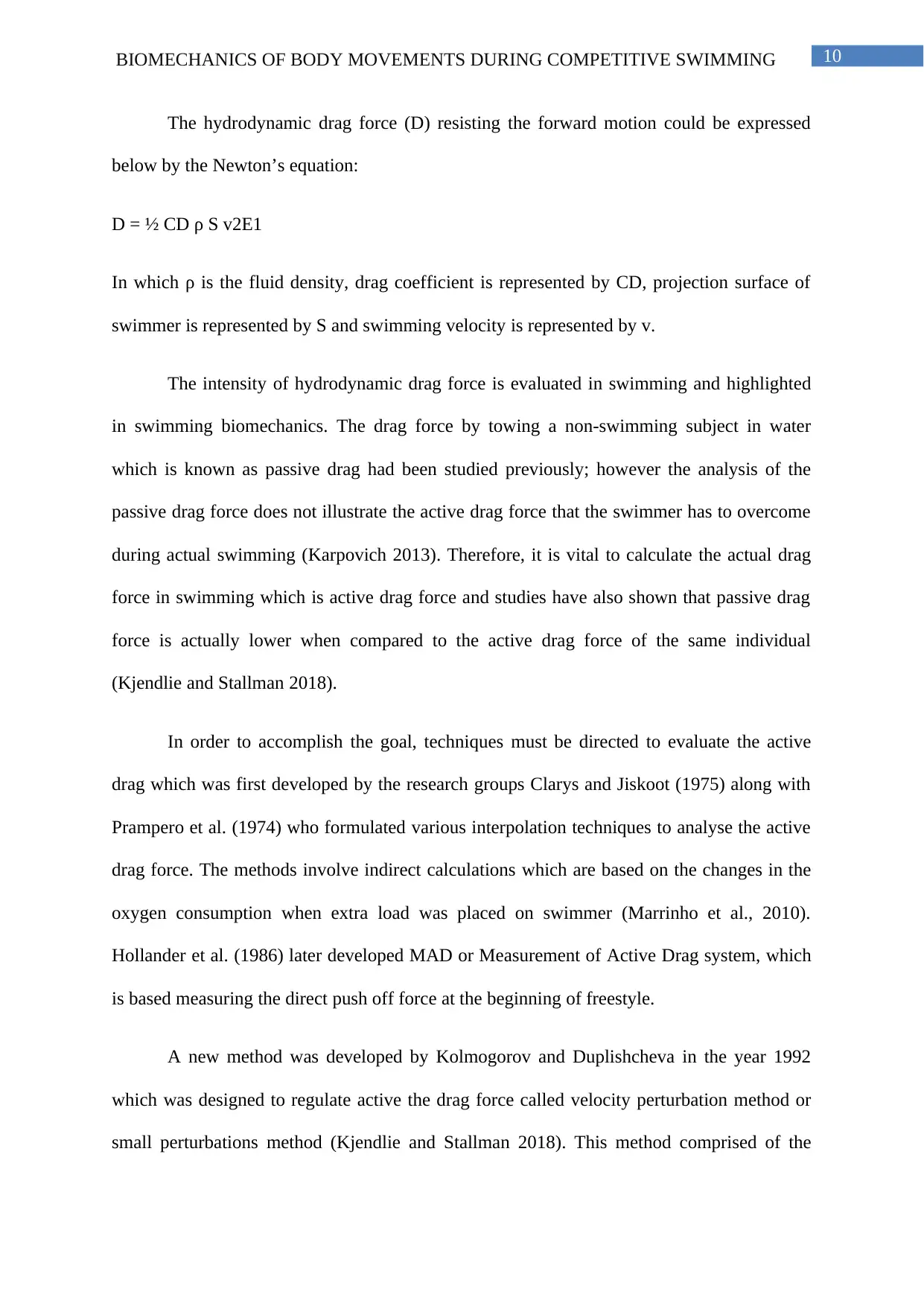
10BIOMECHANICS OF BODY MOVEMENTS DURING COMPETITIVE SWIMMING
The hydrodynamic drag force (D) resisting the forward motion could be expressed
below by the Newton’s equation:
D = ½ CD ρ S v2E1
In which ρ is the fluid density, drag coefficient is represented by CD, projection surface of
swimmer is represented by S and swimming velocity is represented by v.
The intensity of hydrodynamic drag force is evaluated in swimming and highlighted
in swimming biomechanics. The drag force by towing a non-swimming subject in water
which is known as passive drag had been studied previously; however the analysis of the
passive drag force does not illustrate the active drag force that the swimmer has to overcome
during actual swimming (Karpovich 2013). Therefore, it is vital to calculate the actual drag
force in swimming which is active drag force and studies have also shown that passive drag
force is actually lower when compared to the active drag force of the same individual
(Kjendlie and Stallman 2018).
In order to accomplish the goal, techniques must be directed to evaluate the active
drag which was first developed by the research groups Clarys and Jiskoot (1975) along with
Prampero et al. (1974) who formulated various interpolation techniques to analyse the active
drag force. The methods involve indirect calculations which are based on the changes in the
oxygen consumption when extra load was placed on swimmer (Marrinho et al., 2010).
Hollander et al. (1986) later developed MAD or Measurement of Active Drag system, which
is based measuring the direct push off force at the beginning of freestyle.
A new method was developed by Kolmogorov and Duplishcheva in the year 1992
which was designed to regulate active the drag force called velocity perturbation method or
small perturbations method (Kjendlie and Stallman 2018). This method comprised of the
The hydrodynamic drag force (D) resisting the forward motion could be expressed
below by the Newton’s equation:
D = ½ CD ρ S v2E1
In which ρ is the fluid density, drag coefficient is represented by CD, projection surface of
swimmer is represented by S and swimming velocity is represented by v.
The intensity of hydrodynamic drag force is evaluated in swimming and highlighted
in swimming biomechanics. The drag force by towing a non-swimming subject in water
which is known as passive drag had been studied previously; however the analysis of the
passive drag force does not illustrate the active drag force that the swimmer has to overcome
during actual swimming (Karpovich 2013). Therefore, it is vital to calculate the actual drag
force in swimming which is active drag force and studies have also shown that passive drag
force is actually lower when compared to the active drag force of the same individual
(Kjendlie and Stallman 2018).
In order to accomplish the goal, techniques must be directed to evaluate the active
drag which was first developed by the research groups Clarys and Jiskoot (1975) along with
Prampero et al. (1974) who formulated various interpolation techniques to analyse the active
drag force. The methods involve indirect calculations which are based on the changes in the
oxygen consumption when extra load was placed on swimmer (Marrinho et al., 2010).
Hollander et al. (1986) later developed MAD or Measurement of Active Drag system, which
is based measuring the direct push off force at the beginning of freestyle.
A new method was developed by Kolmogorov and Duplishcheva in the year 1992
which was designed to regulate active the drag force called velocity perturbation method or
small perturbations method (Kjendlie and Stallman 2018). This method comprised of the
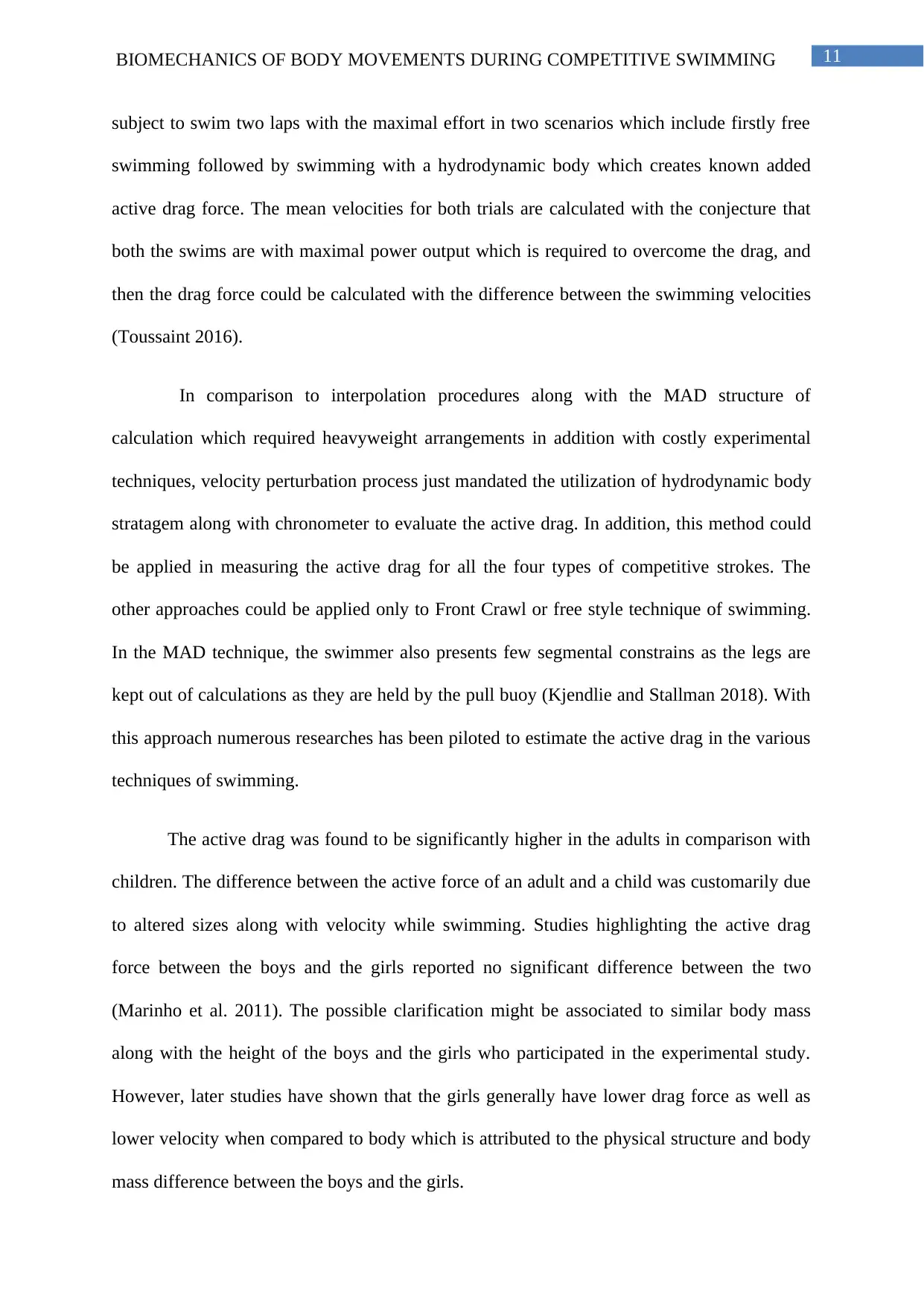
11BIOMECHANICS OF BODY MOVEMENTS DURING COMPETITIVE SWIMMING
subject to swim two laps with the maximal effort in two scenarios which include firstly free
swimming followed by swimming with a hydrodynamic body which creates known added
active drag force. The mean velocities for both trials are calculated with the conjecture that
both the swims are with maximal power output which is required to overcome the drag, and
then the drag force could be calculated with the difference between the swimming velocities
(Toussaint 2016).
In comparison to interpolation procedures along with the MAD structure of
calculation which required heavyweight arrangements in addition with costly experimental
techniques, velocity perturbation process just mandated the utilization of hydrodynamic body
stratagem along with chronometer to evaluate the active drag. In addition, this method could
be applied in measuring the active drag for all the four types of competitive strokes. The
other approaches could be applied only to Front Crawl or free style technique of swimming.
In the MAD technique, the swimmer also presents few segmental constrains as the legs are
kept out of calculations as they are held by the pull buoy (Kjendlie and Stallman 2018). With
this approach numerous researches has been piloted to estimate the active drag in the various
techniques of swimming.
The active drag was found to be significantly higher in the adults in comparison with
children. The difference between the active force of an adult and a child was customarily due
to altered sizes along with velocity while swimming. Studies highlighting the active drag
force between the boys and the girls reported no significant difference between the two
(Marinho et al. 2011). The possible clarification might be associated to similar body mass
along with the height of the boys and the girls who participated in the experimental study.
However, later studies have shown that the girls generally have lower drag force as well as
lower velocity when compared to body which is attributed to the physical structure and body
mass difference between the boys and the girls.
subject to swim two laps with the maximal effort in two scenarios which include firstly free
swimming followed by swimming with a hydrodynamic body which creates known added
active drag force. The mean velocities for both trials are calculated with the conjecture that
both the swims are with maximal power output which is required to overcome the drag, and
then the drag force could be calculated with the difference between the swimming velocities
(Toussaint 2016).
In comparison to interpolation procedures along with the MAD structure of
calculation which required heavyweight arrangements in addition with costly experimental
techniques, velocity perturbation process just mandated the utilization of hydrodynamic body
stratagem along with chronometer to evaluate the active drag. In addition, this method could
be applied in measuring the active drag for all the four types of competitive strokes. The
other approaches could be applied only to Front Crawl or free style technique of swimming.
In the MAD technique, the swimmer also presents few segmental constrains as the legs are
kept out of calculations as they are held by the pull buoy (Kjendlie and Stallman 2018). With
this approach numerous researches has been piloted to estimate the active drag in the various
techniques of swimming.
The active drag was found to be significantly higher in the adults in comparison with
children. The difference between the active force of an adult and a child was customarily due
to altered sizes along with velocity while swimming. Studies highlighting the active drag
force between the boys and the girls reported no significant difference between the two
(Marinho et al. 2011). The possible clarification might be associated to similar body mass
along with the height of the boys and the girls who participated in the experimental study.
However, later studies have shown that the girls generally have lower drag force as well as
lower velocity when compared to body which is attributed to the physical structure and body
mass difference between the boys and the girls.
⊘ This is a preview!⊘
Do you want full access?
Subscribe today to unlock all pages.

Trusted by 1+ million students worldwide
1 out of 30
Your All-in-One AI-Powered Toolkit for Academic Success.
+13062052269
info@desklib.com
Available 24*7 on WhatsApp / Email
![[object Object]](/_next/static/media/star-bottom.7253800d.svg)
Unlock your academic potential
Copyright © 2020–2025 A2Z Services. All Rights Reserved. Developed and managed by ZUCOL.
